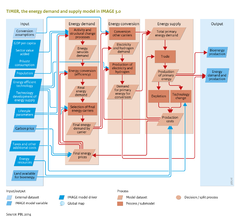Energy supply and demand: Difference between revisions
Jump to navigation
Jump to search
Oostenrijr (talk | contribs) No edit summary |
Oostenrijr (talk | contribs) No edit summary |
||
| Line 1: | Line 1: | ||
{{AggregatedComponentTemplate | {{AggregatedComponentTemplate | ||
|ComponentCode=ESD | |ComponentCode=ESD | ||
|Application=ADVANCE project; | |Application=ADVANCE project; | ||
|IMAGEComponent=Energy demand; Energy supply; Energy conversion; | |IMAGEComponent=Energy demand; Energy supply; Energy conversion; | ||
|Model-Database=POLES model; GCAM model | |Model-Database=POLES model; GCAM model | ||
| Line 9: | Line 9: | ||
|Parameter=Conversion assumptions; Taxes and other additional costs; | |Parameter=Conversion assumptions; Taxes and other additional costs; | ||
|OutputVar=Bioenergy production; Energy demand and production | |OutputVar=Bioenergy production; Energy demand and production | ||
|Description=Energy consumption and production constitutes a central component in discussions on sustainable development. Without the use of energy most human activities are impossible. Hence, securing a reliable and affordable supply of fit-for-purpose energy is an important element of countries' economic and energy policies. Three-quarters of the world's energy supply is fossil fuel. However, over time, depletion of fossil fuel resources is expected to lead to rising prices at least for oil, and easily accessible resources will be concentrated in a decreasing number of countries. Energy consumption and production is also important for environmental reasons –fuel combustion is the single most important source of local and regional air pollution and greenhouse gas emissions. | |Description={{NAMESPACE}} Energy consumption and production constitutes a central component in discussions on sustainable development. Without the use of energy most human activities are impossible. Hence, securing a reliable and affordable supply of fit-for-purpose energy is an important element of countries' economic and energy policies. Three-quarters of the world's energy supply is fossil fuel. However, over time, depletion of fossil fuel resources is expected to lead to rising prices at least for oil, and easily accessible resources will be concentrated in a decreasing number of countries. Energy consumption and production is also important for environmental reasons –fuel combustion is the single most important source of local and regional air pollution and greenhouse gas emissions. | ||
The future of the global energy system is highly uncertain and depends on factors such as technological innovations and breakthroughs, socio-economic developments, resource availability and societal choices. Exploring different scenarios for developments around the use and supply of energy provides information for decision-makers to base strategic policy decisions. | The future of the global energy system is highly uncertain and depends on factors such as technological innovations and breakthroughs, socio-economic developments, resource availability and societal choices. Exploring different scenarios for developments around the use and supply of energy provides information for decision-makers to base strategic policy decisions. | ||
Revision as of 13:29, 17 October 2016
|
Composition of Energy supply and demand Additional info |
| Component is implemented in: |
|
| Projects/Applications |
| Models/Databases |
| Key publications |
| References |
Description of Energy supply and demand
